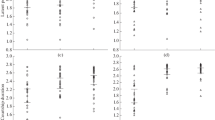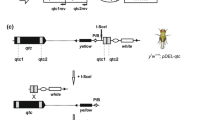Abstract
Drosophila melanogaster males carrying the fruitless mutation have been studied in their interactions with males and females. Mutant males—expressing a single recessive factor on the third chromosome—court mutant or wild-type males about 7 times more frequently than wild-type males court each other. Courtship by a fruitless male of a wild-type male is sustained and takes up an amount of time almost 100 times greater than the courtship interactions recorded between two normal males. While the mutant males do court females in a sustained manner, they attempt to copulate in less than 1% of the trials, never do copulate, and are thus behaviorally sterile. Fruitless males, when interacting with other males, are deficient in their degree of rejection responses, but this defect is not sufficient to explain the abnormal male-male interactions. The mutants stimulate wild-type males to court them with a frequency which is about 5 times higher than that observed between normal males. Fruitless males can stimulate other males to court them even when the former have been etherized or cut into pieces.
Similar content being viewed by others
References
Averhoff, W. W., and Richardson, R. H. (1974). Pheromonal control of mating patterns inDrosophila melanogaster.Behav. Genet. 4:207–225.
Barth, R. H., and Lester, L. J. (1973). Neuro-hormonal control of sexual behavior in insects.Ann. Rev. Entomol. 18:445–472.
Bastock, M. (1956). A gene mutation which changes a behavior pattern.Evolution 10:421–429.
Bastock, M., and Manning, A. (1955). The courtship ofDrosophila melanogaster.Behaviour 8:85–111.
Bell, J. B., and MacIntyre, R. (1973). Characterization of acid phosphatase-1 null activity mutants inDrosophila melanogaster.Biochem. Genet. 10:39–55.
Bennet-Clark, H. D., and Ewing, A. W. (1970). The love song of the fruit fly.Sci. Am. 223:84–92.
Carlson, D. A., Mayer, M. S., Silbacek, D. L., James, J. D., Beroza, M., and Bierl, B. A. (1971). Sex attractant pheromone of the house fly: Isolation, identification, and synthesis.Science 174:76–77.
Cook, R. (1975). “Lesbian” phenotype ofDrosophila melanogaster?Nature 254:241–242.
Dethier, V. G. (1963).The Physiology of Insect Senses. Chapman and Hall, London, pp. 112–126.
Fuyama, Y. (1976). Behavior genetics of olfactory responses inDrosophila. I. Olfactometry and strain differences inDrosophila melanogaster.Behav. Genet. 6:407–420.
Gill, K. S. (1963a). A mutation causing abnormal mating behavior.Drosophila Inform. Serv. 38:33.
Gill, K. S. (1963b). A mutation causing abnormal courtship and mating behavior in males ofDrosophila melanogaster.Am. Zool. 3:507 (abst.).
Hall, J. C., (1977). Portions of the central nervous system controlling reproductive behavior inDrosophila melanogaster.Behav. Genet. 7:291–312.
Hall, J. C., Gelbart, W. M., and Kankel, D. R. (1976). Mosaic systems. In Ashburner, M., and Novitski (eds.),The Genetics and Biology of Drosophila, Vol. 1a, Academic Press, London, pp. 264–314.
Hedin, P. A., Neimeyer, C. S., Gueldner, R. C., and Thompson, A. C. (1972). A gas chromatographic survey of the volatile fractions of twenty species of insects from eight orders.J. Insect Physiol. 18:555–564.
Hotta, Y., and Benzer, S. (1972). Mapping of behaviour inDrosophila mosaics.Nature 240:527–535.
Hotta, Y., and Benzer, S. (1976). Courtship in Drosophila mosaics: Sex-specific foci for sequential action patterns.Proc. Natl. Acad. Sci. 73:4154–4158.
Kankel, D. R., and Hall, J. C. (1976). Fate mapping of nervous system and other internal tissues inDrosophila melanogaster.Dev. Biol. 48:1–24.
Leonard, J. E., Ehrman, L., and Pruzan, A. (1974). Pheromones as a means of genetic control of behavior.Ann. Rev. Genet. 8:179–193.
Lindsley, D. L., and Grell, E. H. (1968). Genetic variations ofDrosophila melanogaster. Carnegie Inst. Wash. Publ. No. 627.
Manning, A. (1965).Drosophila and the evolution of behaviour.Viewpoints Biol. 4:125–169.
Rogoff, W. M., Gretz, G. H., Jacobson, M., and Beroza, M. (1973). Confirmation of (Z)-9-ticosene as a sex pheromone of the house fly.Ann. Entomol. Soc. Am. 66:739–741.
Sharma, R. P. (1977). Light-dependent homosexual activity in males of a mutantDrosophila melanogaster.Experientia 33:171–173.
Shorey, H. H., and Bartell, R. J. (1970). Role of a volatile female sex pheromone in stimulating male courtship inDrosophila melanogaster.Anim. Behav. 18:159–164.
Spieth, H. T. (1952). Mating behaviour within the genusDrosophila (Diptera).Bull. Am. Mus. Nat. Hist. 99:396–474.
Spieth, H. T. (1966). Drosophilid mating behaviour: The behaviour of decapitated females.Anim. Behav. 14:226–235.
Spieth, H. T. (1974). Courtship behavior inDrosophila.Ann. Rev. Entomol. 19:385–405.
Streisinger, G. (1948). Experiments on sexual isolation inDrosophila. IX. Behavior of males with etherized females.Evolution 2:187–188.
von Schilcher, F. (1976). Role of auditory stimuli in the courtship ofDrosophila melanogaster.Anim. Behav. 24:18–26.
Wasserman, M. J., Heller, J., and Zombek, J. (1971). Male determined sexual discrimination in the speciesDrosophila pegasa.Am. Midl. Nat. 86:231–235.
Weier, J. A., and Gesteland, R. C. (1976). Electroantennograms and unit responses of Drosophila olfactory receptors (abst.).Neurosciences Abstracts, Vol. II, Part 1, p. 166 (6th Annual Meeting of Society for Neuroscience, Toronto, November 1976).
Author information
Authors and Affiliations
Additional information
This research was supported by Grant GM-21473 from the U.S. Public Health Service.
Rights and permissions
About this article
Cite this article
Hall, J.C. Courtship among males due to a male-sterile mutation inDrosophila melanogaster . Behav Genet 8, 125–141 (1978). https://doi.org/10.1007/BF01066870
Received:
Accepted:
Issue Date:
DOI: https://doi.org/10.1007/BF01066870




